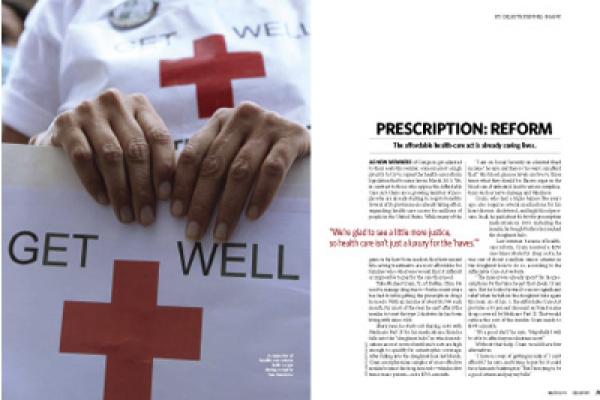As new members of Congress got adjusted to their seats this winter, some made it a high priority to try to repeal the health-care reform legislation that became law in March 2010. Yet, in contrast to those who oppose the Affordable Care Act, there are a growing number of people who are already starting to reap its benefits: Several of its provisions are already taking effect, expanding health-care access for millions of people in the United States. While many of the gains so far have been modest, they have meant life-saving treatments are now affordable for families who otherwise would find it difficult or impossible to pay for the care they need.
Take Michael Cram, 72, of Dublin, Ohio. He used to manage drug stores -- but in recent years has had trouble getting the prescription drugs he needs. With an income of about $1,500 each month, for most of the year he can’t afford the insulin to treat the type 2 diabetes he has been living with since 1991.
Every year, he starts out sharing costs with Medicare Part D for his medications; then he falls into the "doughnut hole," in which medications are not covered until one’s costs are high enough to qualify for catastrophic coverage. After falling into the doughnut hole last March, Cram used physician samples of a less-effective insulin because the drug he needs -- which is five times more potent -- costs $753 a month.
"I am on Social Security on a limited fixed income," he says, and there is "no way I can afford that." His blood glucose levels are two to three times what they should be. Excess sugar in the blood can, if untreated, lead to serious complications such as nerve damage and blindness.
Cram, who had a triple bypass five years ago, also requires several medications for his heart disease, cholesterol, and high blood pressure. In all, he paid about $1,800 for prescription medications in 2010, including the insulin he bought before he reached the doughnut hole.
Last summer, because of health-care reform, Cram received a $250 one-time rebate for drug costs; he was one of about 4 million senior citizens in the doughnut hole to do so, according to the Affordable Care Act website.
"The money was already spent" for his prescriptions by the time he got that check, Cram says. But he looks forward to more significant relief when he falls in the doughnut hole again this year. As of Jan. 1, the Affordable Care Act provides a 50 percent discount on brand-name drugs covered by Medicare Part D. That would reduce the cost of the insulin Cram needs to $376 a month.
"It's a good start," he says. "Hopefully I will be able to afford my medications now."
Without that help, Cram would have few alternatives.
"I have no way of getting insulin if I can't afford it," he says, and trying to pay for it could force him into bankruptcy. "But I'm trying to be a good citizen and pay my bills."
Jan Chapman’s then 22-year-old son, Travis, had told her he didn’t need health insurance because he never got sick.
She and her husband bought him a high-deductible private insurance policy anyway when he left college to play internationally with his band, Balmorhea.
"We can afford a private health insurance policy for our son," says Chapman, 57, who lives in Austin, Texas. "We cannot afford a catastrophic medical event. We don’t have hundreds of thousands of dollars sitting in the bank."
In January 2010, her son called and said, '"Don't be alarmed, but I’m on my way to the hospital,'" Chapman says. He had kidney stones. The total bill was nearly $7,000.
In September, Chapman and her husband were able to put Travis, now 24, back on her husband’s insurance because the Affordable Care Act allows 18- to 25-year-olds to be covered by their parents’ insurance plans. An estimated 1.2 million young adults could benefit, according to the U.S. Department of Health and Human Services.
The Chapman family now can use the extra $130 a month they would have been spending on insurance to instead pay down college debt.
"We're glad to see a little bit more justice in the system, so that health care isn't just a luxury for the 'haves' in this country," Chapman says. Many families can’t pay for even a high-deductible policy, she says. "There are an awful lot of hardworking people who can't afford that."
"We know we're just very fortunate, and we just can't stand the idea that people are making medical decisions differently because they don’t have insurance," Chapman says.
Her family has seen the detrimental results of those decisions. A friend of Chapman's oldest son died after having a fever and a seizure. He delayed going to the doctor because of lack of health coverage.
And Chapman's own father had a heart attack at age 58 while uninsured. He died a week later in the hospital. He had "worked hard his whole life and made a very good living for his wife and four daughters, but in his 50s sold his company," she says. He was in between group insurance policies, and when he got a new job, heart disease was considered a pre-existing condition, as he had had a heart attack at 53.
"We asked him on the last day of his life, 'Why did you have chest pains all day and night and not go to the hospital?' and he said, ‘I don’t have health insurance,'" Chapman recalls.
SONJI AND NATHAN Wilkes of Arapahoe County, Colorado, have worries most other parents don't. They can't let their son, Thomas, 7, play contact sports. "If we go to a baseball game, we are definitely thinking, 'Are we in foul-ball range?'" says Sonji.
And because of insurer-imposed lifetime limits for coverage, they have had to go to unusual lengths to get health insurance for Thomas.
Thomas has hemophilia, a blood-clotting disorder, and he needs intravenous medication for 10 to 15 minutes a day. "Right now our burn rate is about half a million dollars a year," says Nathan about Thomas' medical costs. "If nothing else changes other than that he gets taller and bigger, his dose will increase. By the time he is 18, he will probably have spent $10 million."
When Thomas was born, and diagnosed with severe hemophilia the next day, the family had good coverage through Nathan Wilkes' job. "We started to realize that the cost of his care to keep him healthy was quite literally destroying the good insurance plan my employer was offering to employees," Nathan says. He and his co-workers had to change their plan to have a high deductible, a high premium, and a $1 million lifetime cap.
"I cried," Sonji Wilkes says. "I couldn’t fathom how we would take care of Thomas." At that point Thomas' medical costs were $750,000 to $1 million a year because of complications.
After reaching that cap in about a year, the family enrolled Thomas in a state high-risk pool, paying a premium to Nathan’s employer for himself, his wife, and their two daughters, ages 9 and 5, and an additional premium for the state pool. But that plan also had a $1 million cap.
As they approached the second cap, they searched for options. Several social workers suggested that they get a divorce on paper, so the children would be in Sonji’s custody and could qualify for Medicaid.
"That's not our family values," Nathan says. "It underscored everything that we knew was wrong with the system we had." In late 2006 and early 2007, the couple became vocal advocates for health-care reform.
To get coverage for Thomas, they started their own business to be able to buy insurance as an employer. "We basically set up a corporation so that Nathan could be consulting for his former employer and buy our own insurance," Sonji says.
As a result of the Affordable Care Act, securing coverage is easier for the family, as lifetime limits on costs are now banned. "That's a huge burden off of our shoulders," as Sonji puts it.
Additionally, employment-related and individual plans issued after Sept. 23, 2010, can no longer exclude children younger than 19 because of pre-existing health conditions. "That's probably what touched me in the heart the most, because it took away some of the stigma of being a family with a chronically ill member," Sonji says.
As recently as the 1960s, many people with hemophilia didn’t live past early adulthood. "Now, Thomas' life expectancy is that of any normal human being, as long as he has access to his medications," Sonji Wilkes says. "Having no lifetime caps is critical to having access to his medications."
Tim Fraas, 53, of Elgin, Illinois, had a series of bad days.
On one of them, in November 2006, he was fatigued and out of breath. Medical testing revealed he needed a heart transplant.
He went back to work, as a land surveyor, until another bad day when he went back to the doctor, whose comment Fraas remembers well.
"When a cardiologist tells you you look like crap, you know it’s not a good day," Fraas says. He went home with medication and a heart pump, but soon he was back at the doctor, for what turned out to be several months in the hospital.
Fraas' insurance paid for most of the costs, including for the heart transplant itself, which he had in October 2008.
"It's just an incredible miracle," he says. "I'm the luckiest guy you’re going to talk to today."
Then the bills came. He saw he was within about half a million of his lifetime limit for coverage. Fraas and his wife still have medical costs. He takes two medications daily so that his body’s immune system does not reject the donor heart. The pills cost about $100 each. "If I don't take them, I die," he says. "You don't think about how much it costs to stay alive."
They have used up the equity in their house and their retirement savings to pay for their share of medical costs, and by last summer they were close to Fraas’ lifetime cap of $3 million.
"That was getting really scary," he says; "$3 million seems like a lot of money until you have a heart transplant. All of a sudden, $3 million is nothing."
On top of that, and college expenses for their daughter, they had less income, as he has worked less since the transplant in order to heal.
"I need to be a good steward of this awesome gift I was given," he says. Yet that means a smaller paycheck, even as paying for his share of medical costs wiped out his family’s home equity and retirement savings.
"I volunteer at the local soup kitchen," Fraas says. "It doesn’t take much to be on the other side of that line."
After two Affordable Care Act provisions went into effect Sept. 23, Fraas and his wife could stop worrying about the lifetime limits for his essential benefits, and keep their daughter on his wife’s insurance. More than 100 million people in the United States had lifetime limits on their insurance, according to the Affordable Care Act website.
These days, Fraas is grateful to be able to continue his ministry with children in the Lutheran congregation where he is a member.
He also tells his faith story to people he meets online who are waiting for organ transplants. "The only thing that got me through this experience is faith," he says.
He hopes health-care reform will stay in place. "It's really not that radical of a change," he says. "I'm afraid it's going to get lost to someone trying to make a point politically."
Celeste Kennel-Shank is a Sojourners contributing writer.

Got something to say about what you're reading? We value your feedback!
